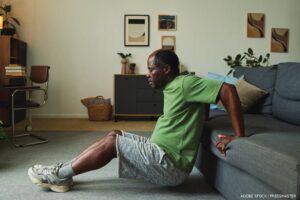 Exercise is something of a dichotomy: It has proven benefits in preventing and mitigating a wide range of chronic diseases, yet it can also induce acute inflammation. Exercise, for example, can simultaneously induce production of interleukin (IL) 6, a pro-inflammatory cytokine, and the very anti-inflammatory IL-10 cytokine. “It’s really the balance of the two that we believe is important for the overall interpretation in the immune system, how they sense these signals and decide what to do,” says Kameron Rodrigues, PhD, a post-doctoral researcher in the Division of Immunology and Rheumatology, Department of Medicine, Stanford Medicine, Palo Alto, Calif.
Exercise is something of a dichotomy: It has proven benefits in preventing and mitigating a wide range of chronic diseases, yet it can also induce acute inflammation. Exercise, for example, can simultaneously induce production of interleukin (IL) 6, a pro-inflammatory cytokine, and the very anti-inflammatory IL-10 cytokine. “It’s really the balance of the two that we believe is important for the overall interpretation in the immune system, how they sense these signals and decide what to do,” says Kameron Rodrigues, PhD, a post-doctoral researcher in the Division of Immunology and Rheumatology, Department of Medicine, Stanford Medicine, Palo Alto, Calif.
Inflammation can be triggered by the presence of cell-free DNA, and research has found that pregnancy, cancer, autoimmune diseases, viral infections and exercise all induce the release of cell-free DNA into the body’s circulation.1 For the immune system’s neutrophils, macrophages and dendritic cells, DNA release can occur via an unusual phenomenon known as ETosis. During this kind of rapid cell death, a cell ejects its DNA and antimicrobial enzymes, in the form of sticky, net-like structures, to trap and neutralize perceived threats, such as microbes.
“ETosis is a way for cells to be like superheroes, almost like Spider-Man; they release these nets, and they capture their enemies,” Dr. Rodrigues says. Unlike superheroes, however, for cells the process is self-sacrificing because the immune cells cannot live long without their DNA.
In neutrophils, the immune system’s already short-lived first responders, ETosis primarily serves to trap and neutralize pathogens, such as bacteria and fungi. The process is less common in macrophages and dendritic cells, although it can play an auxiliary role in pathogen defense, along with the cells’ more dominant functions of phagocytosis and antigen presentation. How exercise may trigger the ETosis mechanism isn’t yet clear, although studies have considered shear stress, temperature change, oxygen levels and heart rate among the contributing factors.
A recent study by Dr. Rodrigues and colleagues in the Proceedings of the National Academy of Sciences sought to clarify which cell types are ejecting cell-free DNA during bouts of exercise and how that release modifies the immune system’s response to exercise.2 The initial results, albeit from a small sample size, found that high-intensity workouts may actually reduce the release of cell-free DNA and tamp down inflammation over time. If the evidence bears out in a larger study, Dr. Rodrigues says, one potential implication is that regular aerobic activity could have protective benefits against autoimmune and other inflammatory conditions.
For the study, he and colleagues recruited 10 young men and randomly assigned half to a high-intensity tactical training program, akin to the rigorous exercise regimen of Navy Seals, and the other half to a traditional, moderate-intensity training program. Both programs combined endurance and resistance training three times a week for 12 weeks. Researchers collected plasma from the volunteers at weeks 0 and 12, just before and immediately after they exercised, and then again after four weeks of de-training, during which they didn’t exercise at all. A research algorithm used the cell-specific pattern of DNA methylation marks—akin to a molecular fingerprint for each cell type—to identify the source of the cell-free DNA.
The analysis, Dr. Rodrigues says, showed that most of the cell-free DNA was being released when the volunteers exercised and in amounts proportional to their workout intensity. The bulk came from their neutrophils though a significant fraction originated in their dendritic cells and macrophages; careful measurements suggested ETosis was the likely source of that expelled DNA. Over time, however, the overall amount of released cell-free DNA decreased for the high-intensity training group but not for the traditional-intensity group.
Multiple Effects of Exercise Training
“What’s interesting is that reduction [of released cell-free DNA] seems to be driven by the dendritic cells and the macrophages, but not the neutrophils,” Dr. Rodrigues says. The neutrophils’ propensity toward ETosis wasn’t impacted even by high-intensity training. In other words, fewer macrophages and dendritic cells were committing themselves to the cell death pathway over time. The gradual reduction suggested the latter cells were becoming less activated by, or perhaps less sensitive to, inflammatory signals via an as-yet unclear mechanism.
“If the cells are becoming less sensitive to inflammatory signals, that could definitely be beneficial in patients with autoimmunity,” Dr. Rodrigues says.
The packaging and ejection process that occurs during ETosis can include DNA from the cell nucleus only or from both the nucleus and the mitochondria, the cell’s powerhouses. When Dr. Rodrigues and colleagues sequenced the ejected cell-free DNA, they found the vast majority was nuclear in origin, suggesting the neutrophils’ mitochondria were still intact and giving the cells enough time to finish their immune surveillance duties before expiring, a finding consistent with what’s known as “vital” ETosis.
The finding also suggested that mitochondrial DNA from neutrophils, which can readily activate dendritic cells and macrophages in a pro-inflammatory way, wasn’t doing so in this case.
“What we’re seeing is that exercise seems to be pushing this process toward just releasing nuclear DNA and not the mitochondrial DNA, and so it’s keeping those danger signals within the cells and not activating the immune system,” Dr. Rodrigues says. “It’s remarkable that [we have] evolved [so that exercise does] not over-activate the immune system or trigger things that would be bad for us.”
Instead, regular exercise may effectively hone the immune system’s ability to appropriately respond to pathogens.
As both groups of volunteers continued their exercise training, the study also found the release of anti-inflammatory IL-10 after exercise remained robust after weeks of exercising, while the release of pro-inflammatory IL-6 levels gradually weakened in a dose-dependent way.
“That suggests the anti-inflammatory signals are relatively stronger overall with continued exercise,” Dr. Rodrigues says. In particular, aerobic exercise, such as running, swimming and walking, is likely to have a bigger inflammation-dampening effect than resistance exercises like weightlifting.
Although all subjects in the study released cell-free DNA as they exercised vigorously, the levels varied enormously from person to person. Dr. Rodrigues says he’d love to probe any links between those levels and common genetic variants, with the suggestion that some people with autoimmune conditions might be better candidates than others for this kind of prescription exercise. “Their bodies might be more sensitive to some of these signals, whereas others might be less so,” he says.
Repeating the study in a larger group would be a good next step toward validating the results, Dr. Rodrigues adds. He’d also love to see more research aimed at identifying how exercise triggers the activation of neutrophils, macrophages and dendritic cells at the molecular level.
In the meantime, his results have significantly changed how he views exercise. “Every time I go up a flight of stairs, I’m always thinking about my macrophages and how they’re releasing less cell-free DNA over time, and how the overall process is helping make my body more anti-inflammatory and more fit, and reducing my risks for all sorts of diseases,” he says.
Bryn Nelson, PhD, is a medical journalist based in Seattle.
References
- Caggiano C, Celona B, Garton F, et al. Comprehensive cell type decomposition of circulating cell-free DNA with CelFiE. Nat Commun. 2021 May 11;12(1):2717.
- Rodrigues KB, Weng Z, Graham ZA, et al. Exercise intensity and training alter the innate immune cell type and chromosomal origins of circulating cell-free DNA in humans. Proc Natl Acad Sci U S A. 2025 Jan 21;122(3):e2406954122.
